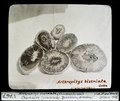| Arthropitys Temporal range: Carboniferous–Late Triassic, 318.1–247.2 Ma PreꞒ Ꞓ O S D C P T J K Pg N Bashkirian–Olenekian | |
|---|---|

| |
| A. bistriata fossils from Chemnitz in 1964 | |
| Scientific classification | |
| Kingdom: | Plantae |
| Clade: | Tracheophytes |
| Division: | Polypodiophyta |
| Class: | Polypodiopsida |
| Subclass: | Equisetidae |
| Order: | Equisetales |
| Family: | †Calamitaceae |
| Genus: | †Arthropitys Frenzel, 1751 |
| Species | |
| |
Arthropitys is an extinct genus of calamitacean equisetale. The petrified fossils of Arthropitys bistriata, the type species, can be found in the Leukersdorf Formation, Chemnitz petrified forest, Chemnitz, Germany. The genus existed from the Carboniferous (Bashkirian) until the Early Triassic (Olenekian).
History
The first remains of Arthropitys were discovered in the early 16th century and were described by Georgius Agricola (1494–1555) in 1546.
In the mid-18th century, gemstone prospector David Frenzel (1691–1772) found numerous examples of this wood in the hills in and around Chemnitz.
One of Frenzel's 1751 finds is one of the few petrified wood specimens still possessing its roots. Later a collector, the Hilbersdorf contractor Güldner, bequeathed some of the petrified logs to King Albert Museum in Chemnitz. The first director of the Museum, Johann Traugott Sterzel, took over the investigation of the findings. The Sterzeleanum in the museum (the petrified forest display) is dedicated to him.
The genus Arthropitys was named and described by Frenzel (1751) and the type species A. bistriata was named by Cotta (1864). The type locality for A. bistrata and A. sp. is the Chemnitz petrified forest.
From April 4, 2008, to Fall 2011, an excavation in Hilbersdorf was held to find and research more trunks. Their researchers discovered, amongst others, Arthropitys bistriata. Many more plants and animals from this excavation are still being used for ongoing research.
A. deltoides was named by Cichan and Taylor (1983) and was discovered in Kentucky.
A. taoshuyuanensis was named by Chen et al. (2018) from specimens found in the Wutonggou Formation of China.
A. buritiranensis was named by Neregato et al. (2021) from specimens found in the Motuca Formation of Brazil.
Distribution
Specimens have also been discovered in Belgium, Brazil, China, Germany, Italy, the Netherlands, Russia, Spain, the UK and the US (Illinois, Indiana, Kentucky and Ohio).
Classification
Rößler, Feng & Noll (2012) classified Arthropitys within Calamitaceae.
Gallery
-
Two Arthropitys .sp fossils discovered in Italy
-
 A. bistriata fossils from Chemnitz
A. bistriata fossils from Chemnitz
-
 Fossils from the petrified forest of Chemnitz in which Arthrophitys .sp is common. Located in Chemnitz occurrence on display in the courtyard of DASTietz and Museum of Natural History Chemnitz
Fossils from the petrified forest of Chemnitz in which Arthrophitys .sp is common. Located in Chemnitz occurrence on display in the courtyard of DASTietz and Museum of Natural History Chemnitz
References
- ^ Neregato, R.; Rößler, R.; Noll, R.; Rohn, R. (2021). "New petrified calamitaleans from the Permian of the Parnaíba Basin, central-north Brazil, part III, with some concerns regarding anatomical features of Paleozoic petrified sphenophytes". Review of Palaeobotany and Palynology. 293: Article 104499. Bibcode:2021RPaPa.29304499N. doi:10.1016/j.revpalbo.2021.104499.
- ^ Fayao Chen; Xiao Shi; Jianxin Yu; Hongfei Chi; Jun Zhu; Hui Li; Cheng Huang (2018). "Permineralized calamitean axes from the Upper Permian of Xinjiang, Northwest China and its paleoecological implication". Journal of Earth Science. 29 (2): 237–244. doi:10.1007/s12583-017-0941-3. S2CID 133735122.
- ^ Ronny Rößler; Zhuo Feng; Robert Noll (2012), "The largest calamite and its growth architecture - Arthropitys bistriata from the Early Permian Petrified Forest of Chemnitz", Review of Palaeobotany and Palynology, 185 (185): 64–78, Bibcode:2012RPaPa.185...64R, doi:10.1016/j.revpalbo.2012.07.018
- Senckenberg Gesellschaft für Naturforschung Chemnitzer Wald ist 291 Millionen Jahre alt
- ^ C. W. Good. (1975). Pennsylvanian-Age Calamitean Cones, Elater-Bearing Spores, and Associated Vegetative Organs. Palaeontographica 153:28-99
- ^ I. A. Dobruskina. (1982). Triassic Floras of Eurasia. Akademia Nauk SSSR, Transactions 365:1-196
- A forest of precious stones – given by volcanoes – the Sterzeleanum, Museum of Natural History, Chemnitz, retrieved 2013-05-08
- H. N. Andrews. (1970). Index of Generic Names of Fossil Plants, 1820-1965. Geological Survey Bulletin 1-354
- Cichan, Michael A.; Taylor, Thomas N. (1983). "A Systematic and Developmental Analysis of Arthropitys deltoides Sp. Nov". Botanical Gazette. 144 (2): 285–294. doi:10.1086/337375. hdl:1808/18009. ISSN 0006-8071.
- ^ J. Galtier. (1997). Coal-ball floras of the Namurian-Westphalian of Europe. Review of Palaeobotany and Palynology 95:51-72
- C. W. Good. (1971). The Ontogeny of Carboniferous Articulates: Calamite Leaves and Twigs. Palaeontographica 133:137-158
- T. L. Phillips and W.A. DiMichele. (1998). A Transect through a Clastic-swamp to Peat-swamp Ecotene in the Springfield Coal, Middle Pennsylvanian Age of Indiana, USA. Palaios 13:113-128
| Taxon identifiers | |
|---|---|
| Arthropitys | |